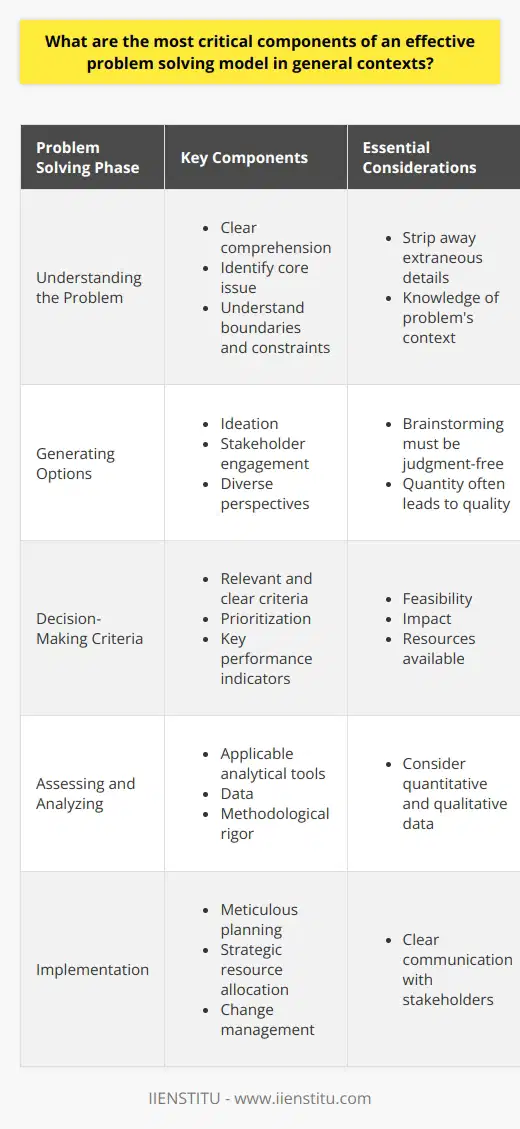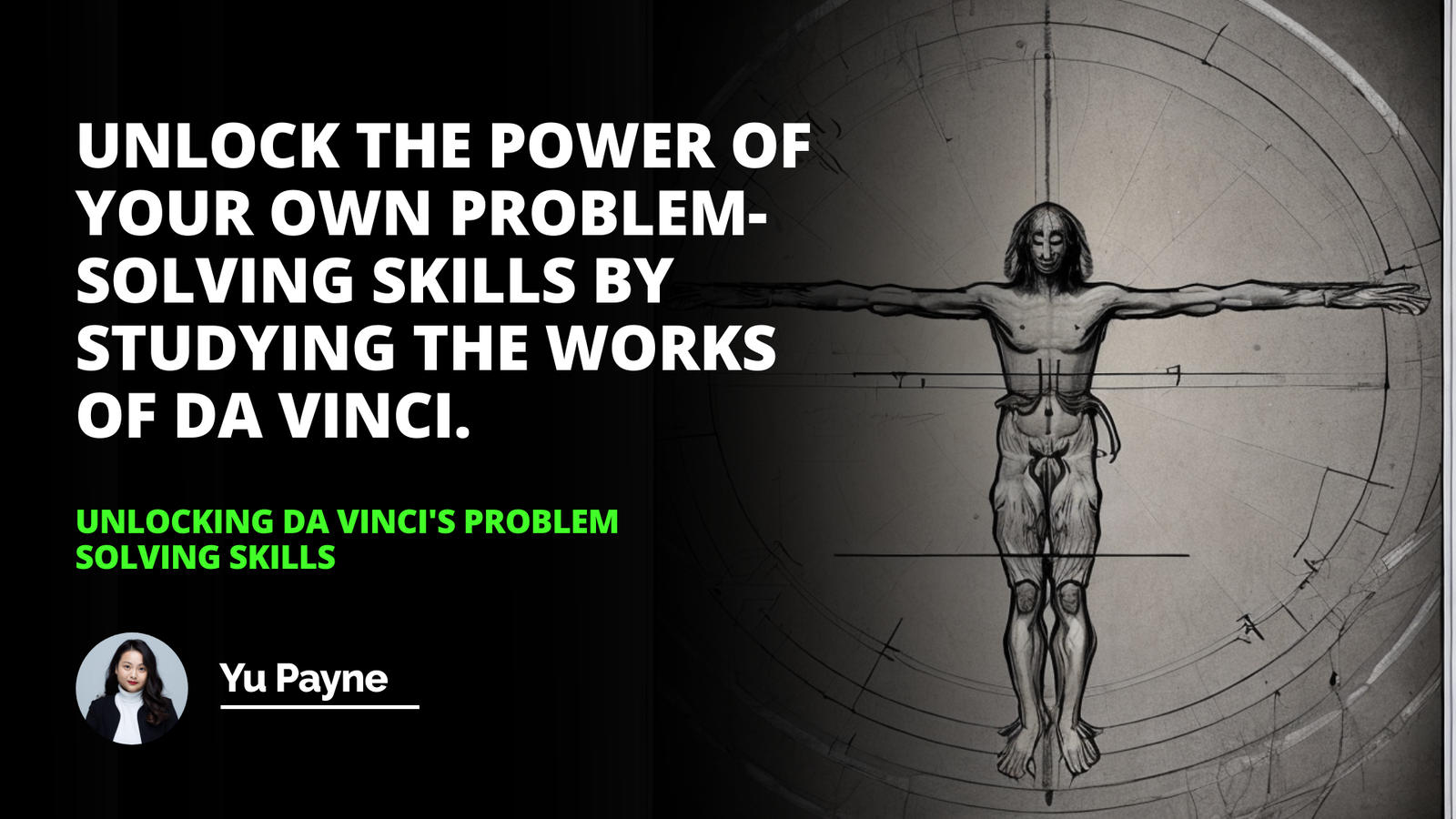
In the complex tapestry of human endeavors, problem solving stands as an indispensable thread, intricately woven into the fabric of both our professional and personal lives. Whether we are navigating the labyrinth of organizational challenges, confronting technical setbacks, or managing interpersonal disputes, the need for robust problem-solving skills is universally recognized.
This necessity has precipitated the development of structured methodologies designed to distill chaos into clarity and uncertainty into actionable strategies. With an expert approach grounded in psychological and managerial sciences, this article offers a comprehensive dissection of the problem-solving model, revealing its integral components and applications.
We will explore the theoretical underpinnings of problem-solving, the meticulous steps involved, and their practical applications in real-life scenarios, all while remaining attuned to the needs and experiences of our readers.
Introduction to Problem Solving
The act of problem solving permeates every sphere of human activity. Problems, defined as any obstruction that impedes our path to a desired outcome, universally demand our attention and resolution. In addressing these inevitable complexities of life, we are often guided, perhaps unknowingly, by underlying models that structure our approach and thought processes. This systematic approach to problem-solving is not just relevant, but essential, providing a scaffold from which we can reliably navigate difficulties both mundane and extraordinary.
In the realms beyond the personal, in the professional world and amid the collaborative efforts of teams and organizations, proficiency in problem-solving assumes a role of heightened significance. Success in these contexts is frequently measured by one's adeptness at identifying issues, formulating solutions, and executing them with efficacy. This skill set, honed through experience and training, has become a prized acquisition, leading many individuals to seek formal acknowledgment of their capabilities through credentials such as a problem solving certification.
Embarking on the journey this blog presents, we delve into the anatomy of the problem-solving model, dissecting its constituent parts to understand the role each plays in the broader process. From the grassroots of recognizing a problem to the crucial analysis of implemented solutions, this article provides an analytical expedition into the labyrinthine world of problem solving, inviting the reader to join in unravelling the complex threads that constitute its fabric.
The Concept of a Problem-Solving Model
At its core, a problem-solving model is an intellectual architecture, a framework that allows us to tackle problems systematically and effectively. Designed to break down the often-intimidating facade of an issue into manageable segments, these models lend structure to our thoughts and actions, instilling a sense of order and purpose in our approach to diverse challenges.
Models serve as cognitive tools which not only maximize efficiency but also enhance the quality of solutions generated, by ensuring that all relevant facets of a problem are considered.
Their utility is evident across various spheres spanning from individual decision-making to the strategic operations of global corporations. Such models are profoundly beneficial, for they provide a universal language of strategy and analysis, unbounded by the specifics of context or industry.
A plethora of problem-solving models exist, each with its peculiarities and specialized applications. From the heuristic simplicity of trial-and-error methods to intricate algorithmic approaches grounded in mathematical logic, the spectrum is broad and eclectic.
Certain models prioritize rapid action and are favored in crisis management scenarios, while others lean towards thorough analysis and are applied in research and development. Regardless of their nuances, each model shares a common goal: to facilitate the identification, investigation, and resolution of problems in a methodical manner.
Key Components of a Problem-Solving Model
Understanding the intricacies of a problem is the first step in any effective problem-solving model. This phase is essential, as misidentification or incomplete understanding of the issue can lead to misguided efforts and ineffective solutions.
Root cause analysis, the practice of peeling back the layers of symptoms to reveal the underlying problem, is a hallmark of this stage.
The journey from recognition to resolution requires a strategic sequence of steps, one of which is the exploration of possible solutions.
The creative spirit of human thinking is at its most valuable here, with brainstorming sessions and lateral thinking exercises broadening the horizon of potential fixes. There is a beauty in the diversity of thought that emerges when multiple stakeholders are rallied behind the task of ideation, unleashing the collective cognitive resources of a group.
After choices have been formulated, their implementation takes center stage. The conversion of abstract concepts into tangible actions marks a critical transition in the problem-solving process.
Moreover, it's the assessment of outcomes that closes the loop; the careful review of results informs future strategies and contributes to a cycle of continuous improvement. It is in the reflection on actions taken—what worked, what didn't, and why—that learning and growth transpire, solidifying the value of the problem-solving endeavor.
Steps Involved in a Problem-Solving Model
A structured problem-solving model often adheres to a series of methodical steps that guide the resolver from problem identification through to the implementation of a solution. Each phase is crucial and resonates with the principles of systematic inquiry and evidence-based action.
Even though the specific nomenclature and number of steps may vary across different models, the underlying philosophy remains consistent: a move from the unknown to the known, from disorder to order.
This process aligns with our cognitive propensities for categorizing and sequencing our thoughts, which in turn mitigates the cognitive load associated with complex problem solving. It also facilitates communication and collaboration, as team members can align their activities to a shared schema.
While some models espouse a linear progression, others adopt a more recursive approach, offering flexibility to revisit and revise earlier steps based on new insights or changing conditions.
Problem Identification
Problem identification is universally acknowledged as a pivotal phase in any problem-solving model. This is where the journey begins, with an acknowledgment that there is a barrier to be surmounted or a gap to be filled.
Techniques employed during this initial step may include asking probing questions, utilizing checklists, conducting interviews, or performing SWOT analyses (Strengths, Weaknesses, Opportunities, Threats).
The accuracy of problem identification sets the stage for the effectiveness of the entire problem-solving process. Failure to correctly pinpoint the root cause or misunderstanding the nature of the problem can derail subsequent efforts, potentially leading to wasted resources or exacerbation of the issue.
Effective problem solvers are detail-oriented and analytical, yet also open-minded and receptive to diverse inputs, ensuring a comprehensive understanding of the problem at hand.
Generating Possible Solutions
Once the problem is clearly defined, the next critical step is brainstorming for potential solutions. During this phase, the free flow of ideas is encouraged, with quantity often valued over quality.
The goal is to generate a wide pool of potential solutions before any critical evaluation takes place, ensuring that creativity is not prematurely stifled.
Flexibility and a departure from conventional thinking are prized in this phase. Being open to unconventional perspectives may unearth novel solutions that would otherwise remain obscured by established thought patterns.
This exercise benefits greatly from diversity, as participants with varied backgrounds and expertise can contribute unique insights that enrich the collective output.
Decision Making
After potential solutions have been laid out, decision making comes into play. During this step, the solutions are sifted through methodically, evaluating each in terms of feasibility, impact, resources required, and potential risks. It's where critical thinking intersects with strategic foresight, leading to the selection of the most promising solution.
Decision-making skills encompass the ability to weigh evidence against goals, to consider both short-term and long-term consequences, and to remain judicious under pressure. The final choice of solution is often a balance between idealism and pragmatism, aspiration and operational capacity.
Solution Implementation
Guiding the selected solution to fruition is the essence of the implementation phase. This step is often multi-faceted, involving planning, resource allocation, delegation, and management. The execution of a solution is a testament to the practical wisdom inherent in the problem-solving model—turning theory into action.
This stage is shaped by meticulous attention to detail and an adaptive mindset, as unforeseen challenges often arise. A well-crafted implementation plan accounts for contingencies and is characterized by clear communication channels and defined milestones, facilitating monitoring and course-correction as needed.
Review and Evaluation
Finally, the problem-solving loop is completed with a thorough review and evaluation of the results. This retrospective analysis not only measures the efficacy of the solution in addressing the initial problem but also serves as an invaluable source of lessons learned, shaping future problem-solving efforts.
The iterative nature of the problem-solving process is particularly evident in this phase, as deficiencies in solution implementation may warrant a return to earlier steps. This continual refinement and learning culminate in organizational resilience and individual growth, as problem-solving proficiency is honed through experience and reflection.
Application of a Problem-Solving Model in Real-life Scenarios
The practical utility of a problem-solving model is perhaps most vividly demonstrated through its application in real-world contexts. These models find relevance across a spectrum of scenarios, from the daily concerns of personal life to the strategic decision-making processes of large corporations. Through an understanding of their function and applicability, individuals and organizations can navigate obstacles with confidence and precision.
Case studies drawn from fields as diverse as healthcare, engineering, business, and education showcase the adaptability and efficacy of these problem-solving frameworks. For instance, whether it's a medical team diagnosing a complex case or a technology firm strategizing a product launch, the principles of a structured problem-solving model remain a steadfast guide to approaching and overcoming challenges.
In synthesizing the vast expanse of information explored in this blog, it becomes evident that the problem-solving model is not merely an academic construct, but a pragmatic guide to action in both personal and professional landscapes. Its key components, from identification to evaluation, function as gears in a sophisticated cognitive machine poised to tackle the multifarious puzzles of our existence.
The recognition of a problem solving certification or an online certificate course is more than an ornamental achievement. It embodies the rigorous training and mastery of this intellectual discipline, equipping individuals with a transferable skill set that transcends domains and industries.
As readers consider the insights offered herein, they are encouraged to observe the workings of these models in their own lives, to regard each problem not as an insurmountable obstacle but as an opportunity for growth and learning. By embracing these frameworks and weaving them into the very fabric of daily practice, one cultivates the essential ability to convert chaos into order, transforming life's myriad challenges into stepping stones on the path to success.
Frequently Asked Questions
What are the most critical components of an effective problem solving model in general contexts?
Understanding the Problem
Effective problem solving begins with clear comprehension. A problem stated is half-solved. One must identify the core issue. This involves stripping away the extraneous details. One seeks to understand the boundaries and constraints. Knowledge of the problem's context is essential.
Generating Options
One cannot overstate the import of ideation. Relevant stakeholders must engage in this process. Diverse perspectives often cultivate novel solutions. Brainstorming must remain judgment-free. Quantity often leads to quality.
Decision-Making Criteria
After generating options, criteria to evaluate them are vital. These criteria must be relevant and clear. Prioritization involves identifying key performance indicators. Feasibility, impact, and resources available are usual suspects.
Assessing and Analyzing
Analysis is a cornerstone of problem solving. One must utilize applicable analytical tools. This phase requires data and methodological rigor. Consider both quantitative and qualitative data.
Decision-Making
This phase is the pivot point. One must commit to a solution. This involves considering the trade-offs carefully. Solutions must align with overarching goals and values.
Implementation
An elegant solution is worthless if not executed. Execution requires meticulous planning. Resource allocation must be strategic. Implementation often involves change management. Stakeholders need clear communication throughout this phase.
Monitoring and Feedback
Post-implementation review is non-negotiable. It involves tracking success indicators. Feedback loops identify unforeseen outcomes. Adaptations may be necessary. Continuous improvement is the end goal.
Learning
One must document the problem-solving journey. Lessons learned become institutional knowledge. They foster better problem-solving cultures. Each problem becomes a learning opportunity.
In summary, problem solving is a multifaceted process. It involves understanding, ideation, evaluation, and decision-making. Critical is the commitment to implement and review outcomes. Continuous learning cements these processes in the fabric of an organization.

How do different components of a problem solving model interrelate and contribute to overall effective implementation?
Breaking Down the Problem Solving Model
Understanding the Model
A problem-solving model offers a structured method for addressing issues. It comprises various components. These elements work together. They enable systematic tackling of complex challenges. Their interrelation becomes critical for effective problem-solving.
Defining the Problem Clearly
The first step involves problem identification. One must grasp the core issue. Clarity at this stage proves essential. It sets the stage for all subsequent actions.
Developing Alternative Solutions
Once defined, the generation of alternatives follows. Here, the diversity of possible solutions comes into play. Creative thinking is crucial. Each potential solution offers a different path forward.
Evaluating and Selecting Alternatives
The next stage involves evaluation. This step assesses feasibility and effectiveness. Decision-making skills become key here. The evaluations lead to informed choices. These choices influence the ultimate success.
Implementing the Solution
With a selected alternative, implementation begins. This step breathes life into the chosen solution. It translates theory into action. Implementation depends on careful planning. It contributes to achieving desired outcomes.
Reviewing and Reflecting on the Process
After implementation comes review. The focus here is on learning. This phase seeks to understand outcomes. Reflecting on each step's effectiveness reinforces the model's value. It informs future problem-solving efforts.
How Components Interrelate
Each component feeds into the next. For instance, a well-defined problem simplifies solution generation. Likewise, strong alternatives lead to better selection decisions.
- Define problems
- Develop solutions
- Evaluate alternatives
- Implement solutions
- Review outcomes
Each step is a building block. Together, they form a comprehensive approach. Interrelation facilitates a sequence that enhances problem-solving.
Contributing to Effective Implementation
The collective performance of these components ensures effective implementation. Sound problem definition prevents misguided efforts. Creative solutions expand possibilities. Rigorous evaluation ensures resources are well applied. Proper implementation turns planning into results. Continuous review optimizes the model over time.
Interrelation is not just sequential. It is also iterative and dynamic. This characteristic allows the problem-solving model to adapt. It can evolve as new information becomes available.
In conclusion, understanding the synergy between the model's components unlocks its potential. It is this interconnectedness that drives successful problem-solving.

What unique approaches or modifications can be made to the existing problem solving model to fit the dynamics of a particular situation or context?
Problem Solving in Context
Problem solving serves as the backbone of human ingenuity. It propels us to overcome challenges. However, there is no one-size-fits-all procedure. Different contexts demand unique approaches. This demands modifications to existing models.
Understanding the Context
First, grasp the situation. Every problem features unique nuances. These nuances shape problem-solving strategies. Take stock of cultural, environmental, and personal factors. They play a critical role.
Modifying the Model
Following this, consider the established problem-solving steps. Start with identification. Each context can distort problem perception. Seek multiple perspectives. This broadens understanding. Next, consider the generation of solutions. Encourage creativity. Frame problems in novel ways. This breeds innovative solutions.
Iterative Process
Remember, problem-solving is iterative. You need to reflect and learn. Solutions may fail. That's part of the process. Document each outcome. It provides valuable insight for future challenges.
Tailored Communication
Communication plays a pivotal role. Every context requires a different approach. Tailors your messaging to your audience. Address beliefs, values, and common knowledge. It ensures effective information exchange.
Leveraging Technology
Technology can offer distinct advantages. Use it wisely. Deploy context-specific tools. They can enhance data gathering and analysis. They can also facilitate collaboration.
Real-World Application
In practice, consider a healthcare setting. Doctors diagnose based on symptoms and tests. They rely on medical knowledge tailored to individual needs. Treatment plans thus also vary. They are patient-specific. Every decision considers the unique patient context.
In contrast, consider an engineering problem. Solutions must account for material properties and physics laws. Engineers must consider environmental conditions. They also factor in user experience.
Flexibility and Adaptability
Throughout this process, flexibility is crucial. Stay open to changing course. Adaptability allows for fitting the model to new information. Rigid adherence to a single method can often be counterproductive.
Collaboration and Diversity
Involve diverse viewpoints. Collaborative efforts expose blind spots. They can enrich the problem-solving process. A variety of backgrounds fosters innovation.
In summary, tailor problem-solving to fit the context. Start with thorough understanding. Modify the model accordingly. Remember, problem solving thrives on flexibility and diverse perspectives. These are keys to success across different situations.



